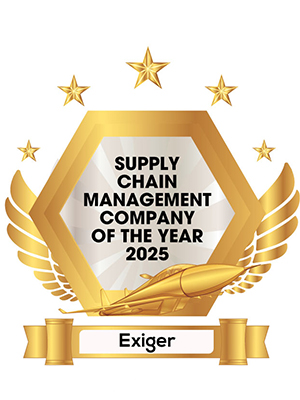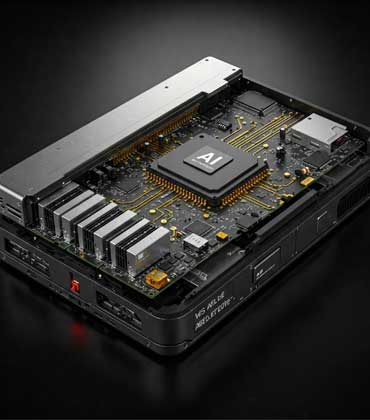THANK YOU FOR SUBSCRIBING
For businesses that rely on global supply chains, visibility has always been a challenge. In an era defined by geopolitical tensions, trade wars, regulatory scrutiny, and economic unpredictability, managing supply chain risks has become more complex than ever. Exiger, a global leader in AI-driven supply chain visibility and risk management, is addressing these challenges by providing organizations with a level of insight never before possible. With a presence spanning multiple continents, a growing customer base that includes over 150 Fortune 500 companies and over 65+ government and defense industrial base organizations, and a proprietary AI platform, 1Exiger, Exiger is revolutionizing the way businesses understand and manage their supply chains. The company has built the largest unified supply chain dataset in the world, enabling it to process over 1.5 trillion data points daily. “The vast, proprietary data lake allows our artificial intelligence systems to break down supply chains to their most fundamental components, giving customers an unmatched ability to identify risks, optimize costs, and make data-driven decisions with confidence,” says Brandon Daniels, CEO of Exiger. A Transformational Approach to Supply Chain Management At the core of 1Exiger’s solution is its ability to create digital supply chain twins. Traditional supply chain mapping has long been a fragmented and reactive process, with companies struggling to track supplier relationships beyond their immediate vendors. Exiger changes this paradigm by allowing businesses to construct a detailed, multi-tiered digital replica of their supply chain infrastructure. The transformation begins with data. Exiger’s AI platform, 1Exiger, can take an engineering drawing or product description and break it down to its fundamental materials. From a simple medical device to a complex aerospace component, the system determines the precise composition of each product, identifying raw materials, specialized manufacturing processes, and associated suppliers. By integrating decades of defense acquisition data, Exiger also provides insight into price trends, procurement histories, and supply chain dependencies. This level of granularity enables companies to predict potential disruptions before they occur.
Top Space Domain Awareness And Missile Warning Solution 2025
In space operations, some of the most critical and complex tasks—missile warning, space domain awareness (SDA), and real-time tracking of high-speed objects—demand deep technical expertise. These high-stakes missions rely not just on advanced radar systems, but also on the engineering excellence that powers them. Yet, in many organizations, management, business development, and growth strategies often take precedence over the technical core. InTrack Radar Technologies (IRT) was founded to change that. Built by engineers, for engineers, IRT is designed with one principle in mind: true mission success begins with technical mastery. Specializing in SDA, Missile Warning (MW), and Missile Defense (MD), IRT partners closely with defense contractors to provide cutting-edge radar and optical tracking solutions. “At IRT, engineering isn’t just what we do—it’s who we are. Our success is built on the relentless pursuit of innovation and the drive to solve the toughest challenges for our clients,” says Morgan Nicholson, CEO of InTrack Radar Technologies. A Complete Picture of Space: Radar and Optical Tracking One of the cornerstones of IRT’s offering is its advanced radar and optical tracking capabilities. By fusing data from both systems, IRT delivers a comprehensive view of space activity—enhancing situational awareness across defense and aerospace missions. The company monitors orbital objects, from active satellites to debris and rocket stages, recognizing the critical need to prevent collisions and disruptions. IRT also excels in high-precision tracking of spacecraft performing rapid maneuvers. In missile defense scenarios, the company supports systems that deliver early warning and real-time situational awareness to detect and respond to threats. With growing geopolitical tensions, having active, modernized, and ready-to-deploy radar systems is vital. IRT not only maintains these systems but enhances them with assets like its Pine Park Observatory in Colorado Springs—a key source of optical tracking data for military and commercial clients alike. Built on Engineering: A Culture That Delivers What truly sets IRT apart is its team. From the beginning, IRT has recruited top talent in radar and SDA engineering. Unlike many competitors where management takes the spotlight, IRT embeds technical experts directly into critical projects. These engineers lead mission analysis, modeling and simulation, and hardware-in-the-loop evaluations—ensuring the final systems are not just theoretical, but battlefield-ready..
AI Accelerator Systems of the Year 2025
Computing technology has evolved along two paths—one pushing the limits of performance, the other prioritizing stability and ruggedness. While conventional platforms seek balance, the extremes diverge. Data centers focus on maximizing power, while edge systems like military vehicles and autonomous tech prioritize durability. However, the emergence of AI and machine learning has rewritten the rules. The high-performance needed at the source of data generation in edge platforms has shattered the old divide, requiring powerful yet durable computing solutions. One Stop Systems (OSS) fills this requirement, delivering data center-level performance with the rugged reliability needed for mission-critical and industrial applications. With a focus on defense and commercial markets, it redefines computing at the edge. “We equip edge users with ultra-low-latency, high-performance computing and data center-level storage capabilities, ensuring powerful AI processing even in the most unforgiving environments where failure is not an option,” says Mike Knowles, president and CEO. This is particularly beneficial in the defense sector, especially with drones, tanks and submarines, requiring real-time sensor fusion, AI/ML processing, autonomy and mission-critical data analysis all essential for tactical decision-making. On the commercial side, OSS brings the same high-performance AI and autonomous processing to industries such as trucking, motorsports, aerospace and agriculture, enabling smarter and more efficient operations. .
CXO INSIGHTS

The Effect of the Supply Chain Issues in the Aerospace Industry
Ken Newton, SCM Engine and Lease Mgmt. Director, Alaska Airlines

Designing Strategies for Innovating Supply Chain Management
Adrian Quinones, Director of Supply Chain, Curtiss-Wright Corporation

An Operator Walks Up to a Machine Tool
Paul Guerrier, Manufacturing Engineering Manager, Moog Inc [NYSE: MOG-A]

Jetsetting Journeys: A Career Soaring from JFK to Unifi's Unique Aviation Landscape
Luigi Taliercio, Vice President of Operations, Unifi

A Silent Force Behind Space Superiority
Corey L. Trusty, Lt Col, Military Deputy, International Affairs Space Division, United States Space Force (USSF)

Wheels Up: Inside the Relentless World of AOG
Mark Finger, Manager – AOG Response, Delta Air Lines
IN FOCUS
EDITORIAL
Predictive Supply Chains, AI, and Space Power
In a world where milliseconds shape market positions and satellite trajectories influence global power dynamics, the need for integrated, adaptive systems is no longer optional. Once separate, the domains of logistics, computing, and security are rapidly merging into a single, data-driven continuum. Key developments at this intersection include the reinvention of supply chains through predictive intelligence, the rise of AI accelerator systems as essential computing tools, and the transformation of space domain awareness in response to growing competition beyond Earth’s atmosphere. The restructuring of global supply chains reflects a shift from reactive logistics to proactive, predictive management. Prompted by vulnerabilities exposed during recent global disruptions, organizations are adopting resilient, data-centric models powered by real-time analytics, autonomous control, and end-to-end visibility. Central to this change is the need for computational systems that can process vast, diverse data sets and deliver accurate forecasts—demands increasingly met by specialized computing platforms. AI accelerators have become essential to this evolution. Designed to handle complex machine learning tasks with exceptional speed and efficiency, they mark a fundamental shift in how data is processed and used at scale. In supply chains, they support digital twins and reinforcement learning models that continuously optimize sourcing, inventory, and logistics. Their strategic value is even greater in space applications, where low latency and autonomous operation are critical. Space situational awareness and missile detection have also evolved dramatically, driven by AI-powered sensing and onboard processing. Modern systems now go beyond ground-based radars and delayed analysis; instead, constellations of satellites equipped with edge AI can detect, classify, and respond to threats in real-time. These space-based systems, built on the same AI acceleration technologies used on Earth, reshape early warning systems, deterrence strategies, and national security operations in low-Earth and geostationary orbits. Together, these advances mark a fundamental shift—from systems that react to their environments to those that anticipate and act. This new era spans the physical, digital, and orbital realms, creating architectures that adapt, understand and shape the world around them. This edition highlights Exiger, a global leader in AI-driven supply chain visibility and risk management. Its AI-driven platform allows organizations to trace the origins of their materials, ensuring ethical sourcing and regulatory compliance on a global scale. The magazine also features the expert perspectives of Lance Lau, Director of Training, CommuteAir, and Ron Brown, Avionics Engineering Manager, Kalitta Air. We hope these valuable insights from industry leaders featured in this edition will assist you in making informed decisions for your businesses.

However, if you would like to share the information in this article, you may use the link below:
https://www.aerospacedefenserevieweurope.com/edition/may-2025-27.html











